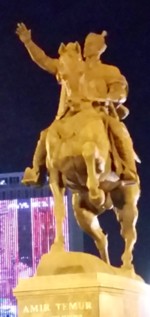China again
Beijing
We returned to OZ via Beijing where we stayed with an expatriate Australian friend and got to see yet another side of that interesting city and revisit the iconic places like Tiananmen Square, where new security has now made access difficult, particularly if arriving by cab. So we resorted to the Metro that seemingly grows by the month yet still requires long walks in this huge city, which might keep one fit if it was not for the air pollution.
Around Tiananmen Square - see also China in 1986 on this website Read More...
I even managed to buy a Guinness at the Irish pub near the Australian Embassy.
Around the Australian Embassy - Beijing
We also spent over half a day in the massive National Museum of China on the eastern side of Tiananmen Square yet failed to see every exhibit.
National Museum of China
Bottom left is a model of an early waterwheel driven blast furnace for making iron - a method invented in China
There are more images in the Northern China Album - Click Here...
By this time we were ready for home.
Guangzhou
We had a seven hour stopover in Guangzhou and having experienced the old terminal there decided to book a nearby hotel. This was a new adventure. If you're like me, when you're tired and in a strange place sometimes the world seems to become more surreal and dreamlike, as one bizarre; unfamiliar and frustrating thing follows the next. This was just such a night.
First, the dreadful old terminal that we'd wished to avoid is gone and in its place are two massive new sterile post-modernist structures. We’ve been told, via email, that getting to the hotel is very straight forward: on no account catch a cab; the hotel shuttle will be sent to meet us at an alpha numeric number; after someone at that location calls them.
We decide it must be a gate or an entrance but there’s no such place in this terminal. No one speaks English. Finally, using sign language, we realise it must be in the other terminal.
There’s a shuttle bus to the other terminal. We’ll have to wait. It's late and we're tired. We decide we’ll ignore the instructions and get a cab straight to the hotel. We have the address but the cab driver clearly has no idea where it is, slowing to squint at our printout, yet again, as we drive off. Clearly he has no idea. Stop! I shout. We get out and walk back, much to his alarm and protestation. But we have no bags in his cab, so he has no recourse. At last the shuttle bus appears. We get to the other terminal. But we're not out of the woods (or in this case the paddy-field) yet.
There was no one waiting at the appropriately numbered door. Maybe they'd given us up? By now it's early morning. We go to a counter and a helpful person calls the number of the hotel and tells us a shuttle is on the way. Twenty minutes. So we wait and wait. Another hour passes. Finally a van appears, people already in it. After picking up more passengers and setting off down the freeway we unexpectedly bounce across the grassy margin onto an unmarked path between the trees. No wonder a cab wouldn't find it! From there it gets really surreal - like something out of Apocalypse Now. Nothing but paddy-fields!
After some time, bouncing along, and several more turns; in the pitch black; in the middle of nowhere; and getting more and more concerned; we turn across a final paddy-field. Incongruously looming beyond the bamboo on the other side, is a twelve storey concrete and glass hotel, somehow mislaid in farmland.
Alighting from the van I notice the forecourt is scattered with promotional cards, picturing girls and a contact number, like those one sees scattered around the streets in Las Vegas (dial 69 6969). But by this time maybe I'm hallucinating?
Yet the room is large and clean, verging on sterile, with a basic but functional bathroom. And the linen is fresh.
The next morning the odd location became apparent. The hotel is on the fringe of a nearby city and our route to it last night was by an illicit shortcut, across-country, from the airport motorway.
After all that waiting and confusion we only got about an hour’s sleep before our multiple alarms sounded. We'd set them early, concerned about similar delays returning. We needn't have feared. The return van delivered us, back along the shortcut through the paddy-fields, directly to the International Terminal. It was a bit too soon but at least we'd had an adventure, instead of sitting around for seven hours on end.
No napalm in the morning nor scantily clad hookers had been encountered; and we were in plenty of time for our flight home to OZ.

